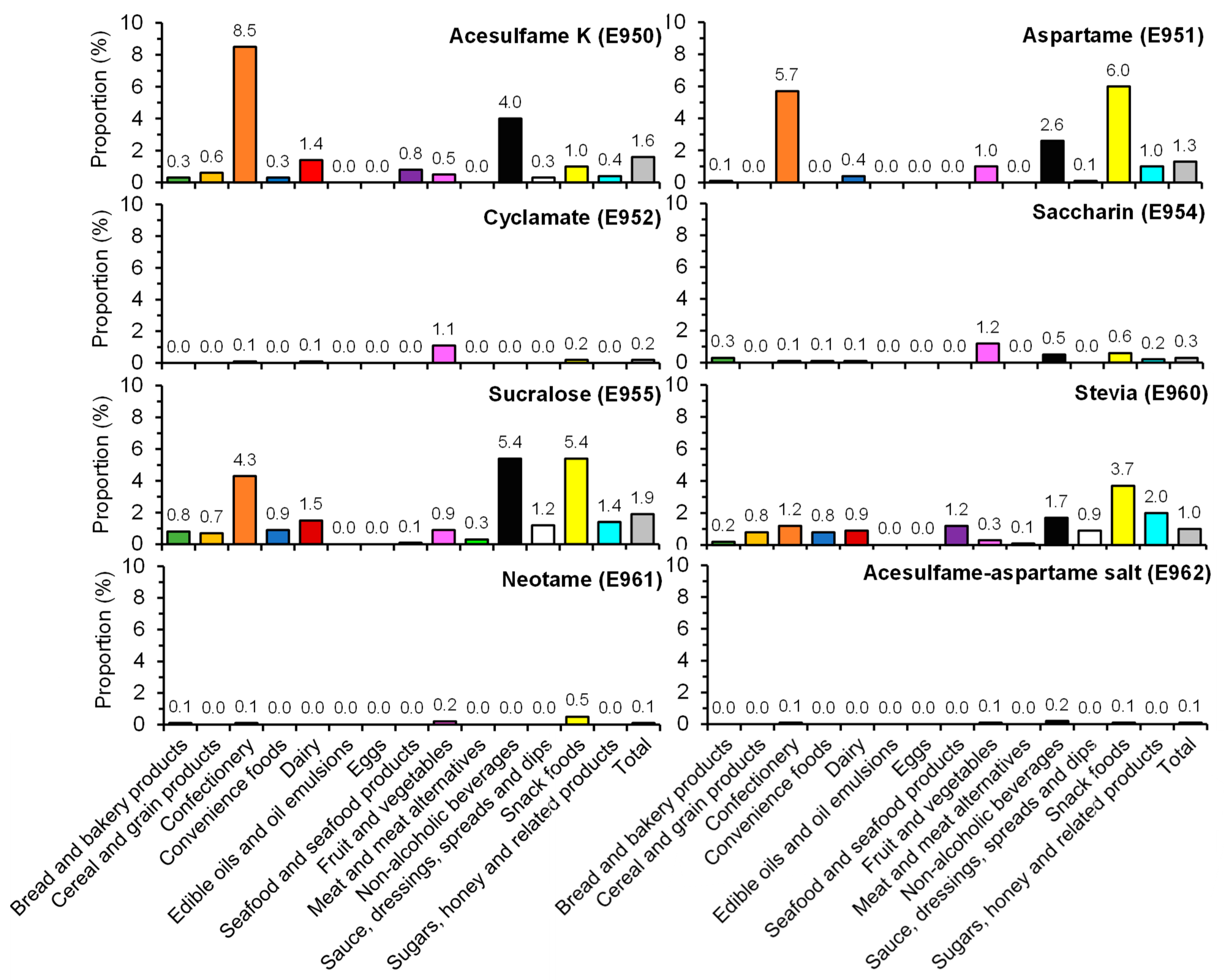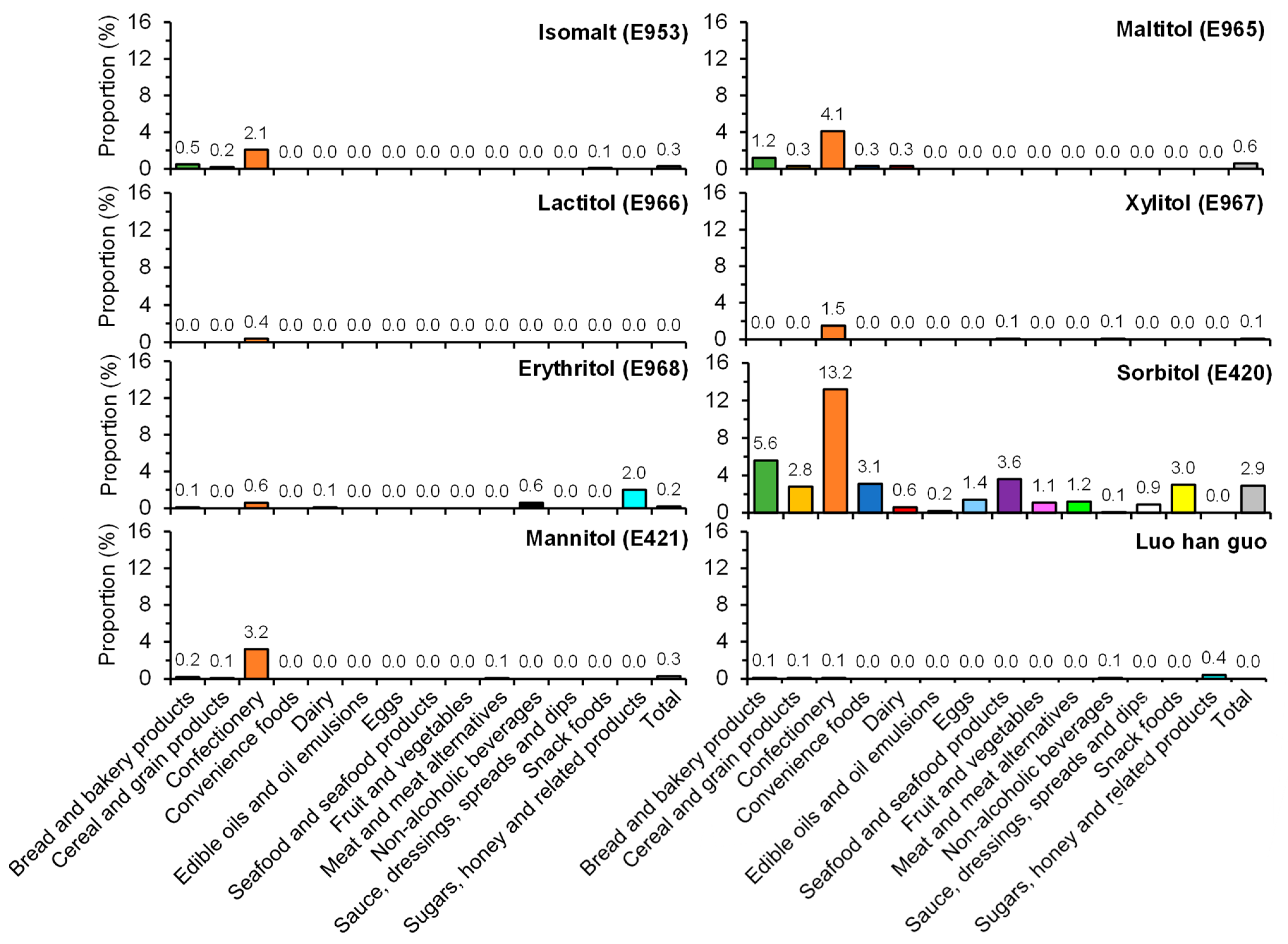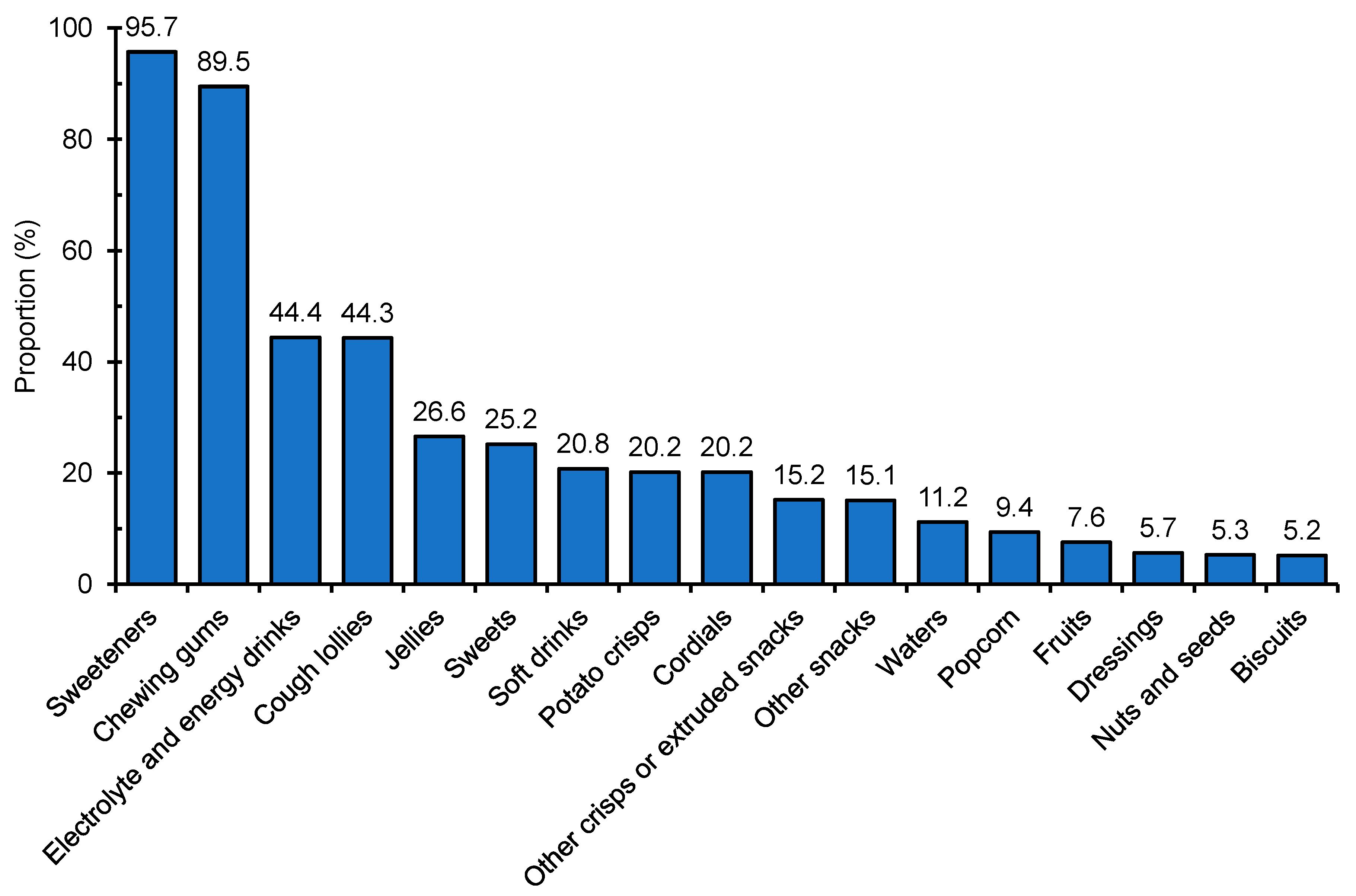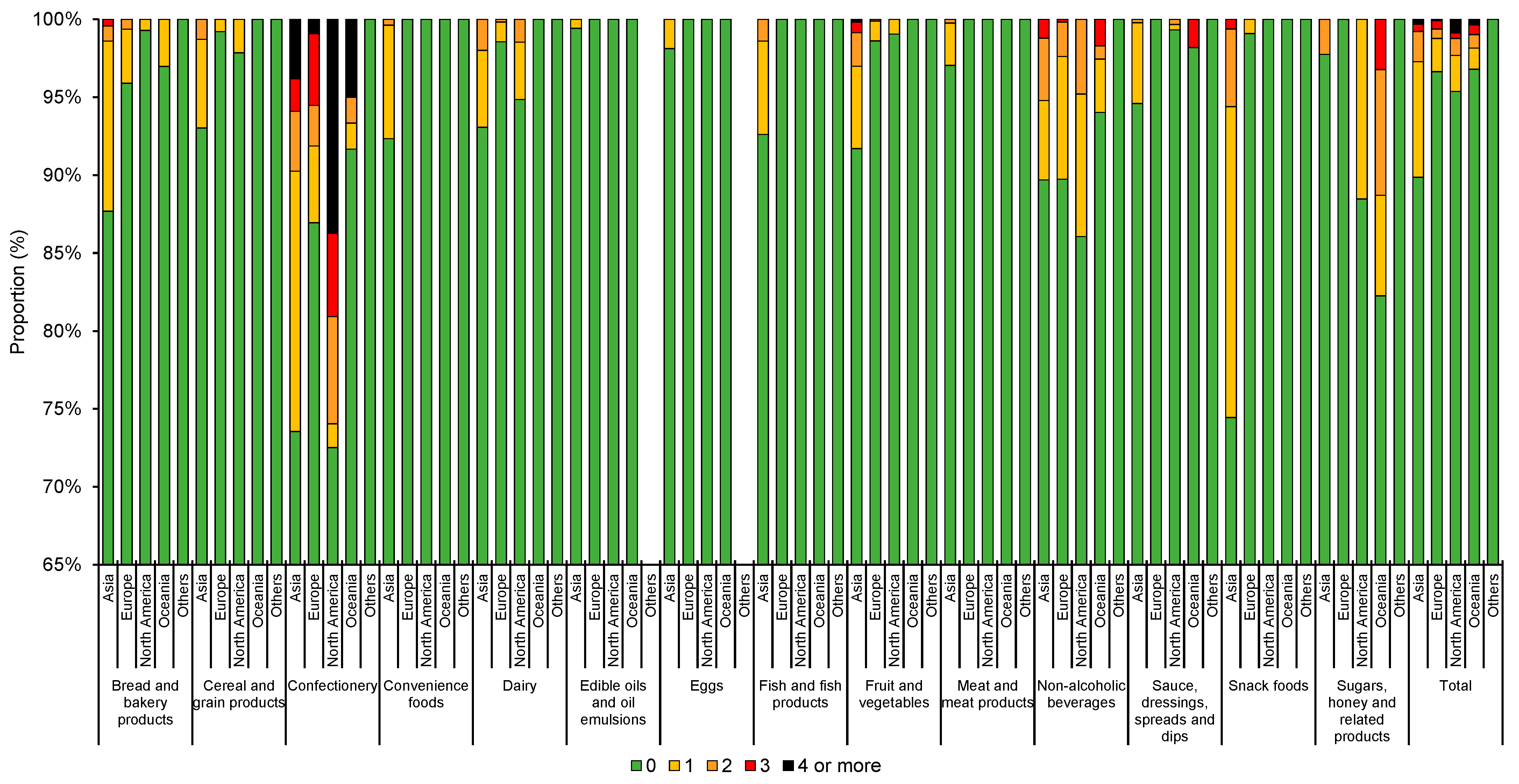The Use of Non-Nutritive and Low-Calorie Sweeteners in 19,915 Local and Imported Pre-Packaged Foods in Hong Kong
Abstract
1. Introduction
2. Materials and Methods
2.1. Data Source
2.2. Data Entry and Processing
2.3. Exclusion Criteria
2.4. Identification of NNSs/LCSs and Free Sugar Ingredients (FSIs)
2.5. Data Cleaning and Statistical Analysis
3. Results
3.1. Types of NNSs and LCSs Used
3.2. Use of NNSs/LCSs by Food Category
3.3. Co-Presence of NNSs, LCSs and FSIs
3.4. Use of NNSs/LCSs by Region of Origin
4. Discussion
5. Conclusions
Supplementary Materials
Author Contributions
Funding
Data Availability Statement
Conflicts of Interest
Ethical Standards Disclosure
References
- Malik, V.S.; Pan, A.; Willett, W.C.; Hu, F.B. Sugar-sweetened beverages and weight gain in children and adults: A systematic review and meta-analysis. Am. J. Clin. Nutr. 2013, 98, 1084–1102. [Google Scholar] [CrossRef]
- Te Morenga, L.; Mallard, S. Dietary sugars and body weight: Systematic review and meta-analyses of randomised controlled trials and cohort studies. BMJ 2012, 346, e7492. [Google Scholar] [CrossRef]
- Lei, L.; Rangan, A.; Flood, V.M.; Louie, J.C.Y. Dietary intake and food sources of added sugar in the Australian population. Br. J. Nutr. 2016, 115, 868–877. [Google Scholar] [CrossRef] [PubMed]
- World Health Organization. Guideline: Sugar Intake for Adults and Children; WHO Department of Nutrition for Health and Development (NHD), Ed.; WHO: Geneva, Switzerland, 2015; p. 50. [Google Scholar]
- Public Health England. Sugar Reduction: Achieving the 20%. A Technical Report Outlining Progress to Date, Guidelines for Industry, 2015 Baseline Levels in Key Foods and Next Steps; Public Health England: London, UK, 2017. [Google Scholar]
- Tamir, O.; Cohen-Yogev, T.; Furman-Assaf, S.; Endevelt, R. Taxation of sugar sweetened beverages and unhealthy foods: A qualitative study of key opinion leaders views. Isr. J. Health Policy Res. 2018, 7, 43. [Google Scholar] [CrossRef]
- Australian Government. About the Partnership. 2018. Available online: http://www.health.gov.au/internet/main/publishing.nsf/Content/about-the-partnership (accessed on 27 September 2018).
- The Department of Health. Healthy Food Partnership Reformulation Program: Evidence Informing the Approach, Draft Targets and Modelling Outcomes; The Department of Health, Ed.; Australian Government: Canberra, ACT, Australia, 2018; Volume 2019. [Google Scholar]
- Sylvetsky, A.C.; Welsh, J.A.; Brown, R.J.; Vos, M.B. Low-calorie sweetener consumption is increasing in the United States. Am. J. Clin. Nutr. 2012, 96, 640–646. [Google Scholar] [CrossRef]
- Drewnowski, A.; Rehm, C. Socio-demographic correlates and trends in low-calorie sweetener use among adults in the United States from 1999 to 2008. Eur. J. Clin. Nutr. 2015, 69, 1035–1041. [Google Scholar] [CrossRef]
- Dunford, E.K.; Miles, D.R.; Ng, S.W.; Popkin, B. Types and Amounts of Nonnutritive Sweeteners Purchased by US Households: A Comparison of 2002 and 2018 Nielsen Homescan Purchases. J. Acad. Nutr. Diet 2020, 120, 1662–1671.e1610. [Google Scholar] [CrossRef]
- Sylvetsky, A.C.; Rother, K.I. Trends in the consumption of low-calorie sweeteners. Physiol. Behav. 2016, 164, 446–450. [Google Scholar] [CrossRef] [PubMed]
- World Cancer Research Fund International. Curbing Global Sugar Consumption: Effective Food Policy Actions to Help Promote Healthy Diets and Tackle Obesity’; World Cancer Research Fund International: London, UK, 2015. [Google Scholar]
- Dunford, E.K.; Taillie, L.S.; Miles, D.R.; Eyles, H.; Tolentino-Mayo, L.; Ng, S.W. Non-Nutritive Sweeteners in the Packaged Food Supply—An Assessment across 4 Countries. Nutrients 2018, 10, 257. [Google Scholar] [CrossRef]
- Centre for Food Safety (Hong Kong). Food and Drugs (Composition and Labelling) Regulations. 2018. Available online: https://www.cfs.gov.hk/english/food_leg/food_leg_cl.html (accessed on 7 January 2021).
- European Union. Regulation (EU) No 1169/2011 of the European Parliament and of the Council of 25 October 2011 on the Provision of Food Information to Consumers. Off. J. Eur. Union 2011, L 304/18. Available online: https://eur-lex.europa.eu/LexUriServ/LexUriServ.do?uri=OJ:L:2011:304:0018:0063:EN:PDF (accessed on 20 November 2020).
- Population Health Division, Department of Health (UK). Technical Guidance on Nutrition Labelling. 2017. Available online: https://assets.publishing.service.gov.uk/government/uploads/system/uploads/attachment_data/file/595961/Nutrition_Technical_Guidance.pdf (accessed on 7 January 2021).
- Wilson, T.; Murray, B.; Price, T.; Atherton, D.; Hooks, T. Non-Nutritive (Artificial) Sweetener Knowledge among University Students. Nutrients 2019, 11, 2201. [Google Scholar] [CrossRef]
- European Food Safety Authority. Statement of EFSA on the scientific evaluation of two studies related to the safety of artificial sweeteners. EFSA J. 2011, 9, 2089. [Google Scholar]
- National Institute of Food and Drug Safety Evaluation. Safety Assessment of Sweeteners. Available online: http://www.nifds.go.kr/nifds/upload/risk/1.%20Safety%20Assessment%20of%20Sweeteners.pdf (accessed on 20 November 2020).
- Centre for Food Safety (Hong Kong). Risk Assessment on Artificial Sweeteners in Beverages. 2003. Available online: https://www.cfs.gov.hk/english/programme/programme_rafs/programme_rafs_fa_01_02_ra.html (accessed on 20 November 2020).
- Pepino, M.Y. Metabolic effects of non-nutritive sweeteners. Physiol. Behav. 2015, 152, 450–455. [Google Scholar] [CrossRef]
- Anderson, G.H.; Foreyt, J.; Sigman-Grant, M. The Use of Low-Calorie Sweeteners by Adults: Impact on Weight Management. J. Nutr. 2012, 142, 1163s–1169s. [Google Scholar] [CrossRef]
- Duffey, K.J.; Steffen, L.M.; Van Horn, L.; Jacobs, D.R., Jr.; Popkin, B.M. Dietary patterns matter: Diet beverages and cardiometabolic risks in the longitudinal Coronary Artery Risk Development in Young Adults (CARDIA) Study. Am. J. Clin. Nutr. 2012, 95, 909–915. [Google Scholar] [CrossRef]
- Tandel, K.R. Sugar substitutes: Health controversy over perceived benefits. J. Pharmacol. Pharmacother. 2011, 2, 236–243. [Google Scholar] [CrossRef] [PubMed]
- Shwide-Slavin, C.; Swift, C.; Ross, T. Nonnutritive Sweeteners: Where Are We Today? Diabetes Spectr. 2012, 25, 104–110. [Google Scholar] [CrossRef]
- Rogers, P.J.; Hogenkamp, P.S.; De Graaf, C.; Higgs, S.; Lluch, A.; Ness, A.R.; Penfold, C.; Perry, R.; Putz, P.; Yeomans, M.R.; et al. Does low-energy sweetener consumption affect energy intake and body weight? A systematic review, including meta-analyses, of the evidence from human and animal studies. Int. J. Obes. 2016, 40, 381–394. [Google Scholar] [CrossRef]
- Azad, M.B.; Abou-Setta, A.M.; Chauhan, B.F.; Rabbani, R.; Lys, J.; Copstein, L.; Mann, A.; Jeyaraman, M.M.; Reid, A.E.; Fiander, M.; et al. Nonnutritive sweeteners and cardiometabolic health: A systematic review and meta-analysis of randomized controlled trials and prospective cohort studies. CMAJ Can. Med. Assoc. J. 2017, 189, E929–E939. [Google Scholar] [CrossRef]
- Karalexi, M.A.; Mitrogiorgou, M.; Georgantzi, G.G.; Papaevangelou, V.; Fessatou, S. Non-Nutritive Sweeteners and Metabolic Health Outcomes in Children: A Systematic Review and Meta-Analysis. J. Pediatr. 2018, 197, 128–133.e122. [Google Scholar] [CrossRef]
- Hunter, S.R.; Reister, E.J.; Cheon, E.; Mattes, R.D. Low Calorie Sweeteners Differ in Their Physiological Effects in Humans. Nutrients 2019, 11, 2717. [Google Scholar] [CrossRef]
- Higgins, K.A.; Mattes, R.D. A randomized controlled trial contrasting the effects of 4 low-calorie sweeteners and sucrose on body weight in adults with overweight or obesity. Am. J. Clin. Nutr. 2016, 109, 1288–1301. [Google Scholar] [CrossRef] [PubMed]
- Magnuson, B.A.; Carakostas, M.C.; Moore, N.H.; Poulos, S.P.; Renwick, A.G. Biological fate of low-calorie sweeteners. Nutr. Rev. 2016, 74, 670–689. [Google Scholar] [CrossRef] [PubMed]
- Food and Health Bureau (Hong Kong). Frequently Asked Questions on Food Supply of Hong Kong. 2016. Available online: https://www.fhb.gov.hk/download/press_and_publications/otherinfo/110318_food_supply_faq/e_food_supply_faq.pdf (accessed on 20 November 2020).
- Wong, A.S.C.; Coyle, D.H.; Wu, J.H.; Louie, J.C.Y. Sodium concentration of pre-packaged foods sold in Hong Kong. Public Health Nutr. 2020, 23, 2804–2810. [Google Scholar] [CrossRef]
- Euromonitor International. Supermarkets in Hong Kong, China: Passport; Euromonitor International: London, UK, 2019. [Google Scholar]
- Apple AppStore. Data Collector. 2019. Available online: https://apps.apple.com/hk/app/data-collector/id545847554 (accessed on 20 November 2020).
- GS1. GS1 Company Prefix. 2020. Available online: https://www.gs1.org/standards/id-keys/company-prefix (accessed on 18 November 2020).
- Dunford, E.K.; Neal, B. FoodSwitch and use of crowdsourcing to inform nutrient databases. J. Food Compost. Anal. 2017, 64, 13–17. [Google Scholar] [CrossRef]
- Hong Kong Government. Sweeteners in Food Regulations. 2019. Available online: https://www.elegislation.gov.hk/hk/cap132U (accessed on 20 November 2020).
- Bernstein, J.T.; Schermel, A.; Mills, C.M.; L’Abbé, M.R. Total and Free Sugar Content of Canadian Prepackaged Foods and Beverages. Nutrients 2016, 8, 582. [Google Scholar] [CrossRef]
- Conceição, M.M.; Fernandes, V.J.; Souza, A.G.; Nascimento, T.G.; Aragão, C.F.; Macedo, R.O. Study of thermal degradation of aspartame and its products of conversion in sweetener using isothermal thermogravimetry and HPLC. Thermochim. Acta 2005, 433, 163–169. [Google Scholar] [CrossRef]
- Ng, S.W.; Slining, M.M.; Popkin, B.M. Use of Caloric and Noncaloric Sweeteners in US Consumer Packaged Foods, 2005–2009. J. Acad. Nutr. Diet 2012, 112, 1828–1834.e1826. [Google Scholar] [CrossRef]
- Kamarulzaman, N.H.; Jamal, K.; Vijayan, G.; Jalil, S.M.A. Will Consumers Purchase Stevia as a Sugar Substitute? An Exploratory Study on Consumer Acceptance. J. Food Prod. Mark. 2014, 20, 122–139. [Google Scholar] [CrossRef]
- Sylvetsky, A.C.; Walter, P.J.; Garraffo, H.M.; Robien, K.; Rother, K.I. Widespread sucralose exposure in a randomized clinical trial in healthy young adults. Am. J. Clin. Nutr. 2017, 105, 820–823. [Google Scholar] [CrossRef] [PubMed]
- U.S. Food & Drug Administration. CFR—Code of Federal Regulations Title 21. 2019. Available online: https://www.accessdata.fda.gov/scripts/cdrh/cfdocs/cfcfr/cfrsearch.cfm?fr=172.804 (accessed on 20 November 2010).
- Gov.UK. Food Labelling and Packaging—Food and Drink Warnings. 2020. Available online: https://www.gov.uk/food-labelling-and-packaging/food-and-drink-warnings (accessed on 20 November 2020).
- Hong Kong Government. Food and Drug (Composition and Labelling) Regulations (Cap. 132, Section 55). 2016. Available online: https://www.elegislation.gov.hk/hk/cap132W (accessed on 20 November 2020).
- Farhat, G.; Dewison, F.; Stevenson, L. Knowledge and perceptions of non-nutritive sweeteners within the UK adult population. Nutrients 2021, 13, 444. [Google Scholar] [CrossRef]
- Mooradian, A.D.; Smith, M.; Tokuda, M. The role of artificial and natural sweeteners in reducing the consumption of table sugar: A narrative review. Clin. Nutr. ESPEN 2017, 18, 1–8. [Google Scholar] [CrossRef] [PubMed]
- Yang, Q. Gain weight by “going diet?” Artificial sweeteners and the neurobiology of sugar cravings: Neuroscience 2010. Yale J. Biol. Med. 2010, 83, 101–108. [Google Scholar]
- Sylvetsky, A.C.; Rother, K.I. Nonnutritive Sweeteners in Weight Management and Chronic Disease: A Review. Obesity 2018, 26, 635–640. [Google Scholar] [CrossRef]
- Liauchonak, I.; Qorri, B.; Dawoud, F.; Riat, Y.; Szewczuk, M.R. Non-nutritive sweeteners and their implications on the development of metabolic syndrome. Nutrients 2019, 11, 644. [Google Scholar] [CrossRef]
- Treesukosol, Y.; Moran, T.H. Cross-generalization profile to orosensory stimuli of rats conditioned to avoid a high fat/high sugar diet. Chem. Senses 2018, 43, 181–188. [Google Scholar] [CrossRef] [PubMed]
- Booth, D.A. Conditioned satiety in the rat. J. Comp. Physiol. Psychol. 1972, 81, 457–471. [Google Scholar] [CrossRef] [PubMed]





| Food Category | Total n in Category | NNSs Only | LCSs Only | NNS + FSI | LCSs + FSI | NNSs + LCSs | NNSs + LCSs + FSIs | FSIs Only | No NNSs/LCSs/FSIs |
|---|---|---|---|---|---|---|---|---|---|
| Bread and bakery products | 1774 | 4 (0.2) | 18 (1.0) | 15 (0.8) | 102 (5.7) | 0 (0.0) | 5 (0.3) | 1497 (84.4) | 133 (7.5) |
| Biscuits | 1085 | 3 (0.3) | 12 (1.1) | 13 (1.2) | 23 (2.1) | 0 (0.0) | 5 (0.5) | 954 (87.9) | 75 (6.9) |
| Breads | 181 | 1 (0.6) | 0 (0.0) | 0 (0.0) | 1 (0.6) | 0 (0.0) | 0 (0.0) | 147 (81.2) | 32 (17.7) |
| Cakes and other bakery items | 508 | 0 (0.0) | 6 (1.2) | 2 (0.4) | 78 (15.4) | 0 (0.0) | 0 (0.0) | 396 (78.0) | 26 (5.1) |
| Cereal and grain products | 2826 | 2 (0.1) | 4 (0.1) | 39 (1.4) | 87 (3.1) | 2 (0.1) | 1 (0.0) | 1120 (39.6) | 1571 (55.6) |
| Breakfast cereals | 466 | 0 (0.0) | 0 (0.0) | 0 (0.0) | 5 (1.1) | 0 (0.0) | 0 (0.0) | 322 (69.1) | 139 (29.8) |
| Cereals and nut-based bars | 118 | 0 (0.0) | 0 (0.0) | 0 (0.0) | 13 (11.0) | 0 (0.0) | 0 (0.0) | 100 (84.7) | 5 (4.2) |
| Noodles | 1127 | 2 (0.2) | 4 (0.4) | 38 (3.4) | 68 (6.0) | 2 (0.2) | 1 (0.1) | 566 (50.2) | 446 (39.6) |
| Pasta, rice or cous cous | 655 | 0 (0.0) | 0 (0.0) | 1 (0.2) | 1 (0.2) | 0 (0.0) | 0 (0.0) | 67 (10.2) | 586 (89.5) |
| Other cereal products | 460 | 0 (0.0) | 0 (0.0) | 0 (0.0) | 0 (0.0) | 0 (0.0) | 0 (0.0) | 65 (14.1) | 395 (85.9) |
| Confectionery | 1710 | 1 (0.1) | 7 (0.4) | 49 (2.9) | 157 (9.2) | 79 (4.6) | 61 (3.6) | 1336 (78.1) | 20 (1.2) |
| Chocolates | 735 | 0 (0.0) | 2 (0.3) | 1 (0.1) | 39 (5.3) | 14 (1.9) | 1 (0.1) | 666 (90.6) | 12 (1.6) |
| Sweets | 658 | 8 (1.2) | 2 (0.3) | 15 (2.3) | 101 (15.3) | 32 (4.9) | 16 (2.4) | 490 (74.5) | 2 (0.3) |
| Chewing gums | 57 | 0 (0.0) | 0 (0.0) | 0 (0.0) | 0 (0.0) | 27 (47.4) | 24 (42.1) | 6 (10.5) | 0 (0.0) |
| Cough lollies | 61 | 0 (0.0) | 1 (1.6) | 2 (3.3) | 3 (4.9) | 5 (8.2) | 16 (26.2) | 33 (54.1) | 1 (1.6) |
| Jellies | 199 | 1 (0.5) | 2 (1.0) | 31 (15.6) | 14 (7.0) | 1 (0.5) | 4 (2.0) | 141 (70.9) | 5 (2.5) |
| Convenience foods | 1171 | 4 (0.3) | 1 (0.1) | 18 (1.5) | 35 (3.0) | 0 (0.0) | 2 (0.2) | 874 (74.6) | 237 (20.2) |
| Dairy | 1611 | 8 (0.5) | 2 (0.1) | 44 (2.7) | 12 (0.7) | 0 (0.0) | 1 (0.1) | 889 (55.2) | 655 (40.7) |
| Edible oils and oil emulsions | 459 | 0 (0.0) | 1 (0.2) | 0 (0.0) | 0 (0.0) | 0 (0.0) | 0 (0.0) | 6 (1.3) | 452 (98.5) |
| Eggs | 74 | 0 (0.0) | 0 (0.0) | 0 (0.0) | 1 (1.4) | 0 (0.0) | 0 (0.0) | 3 (4.1) | 70 (94.6) |
| Seafood and seafood products | 740 | 0 (0.0) | 3 (0.4) | 10 (1.4) | 18 (2.4) | 0 (0.0) | 6 (0.8) | 274 (37.0) | 429 (58.0) |
| Fruit and vegetables | 2525 | 17 (0.7) | 8 (0.3) | 67 (2.7) | 19 (0.8) | 1 (0.0) | 0 (0.0) | 844 (33.4) | 1569 (62.1) |
| Fruits | 460 | 4 (0.9) | 0 (0.0) | 31 (6.7) | 0 (0.0) | 0 (0.0) | 0 (0.0) | 202 (43.9) | 223 (48.5) |
| Herbs and spices | 586 | 0 (0.0) | 2 (0.3) | 3 (0.5) | 4 (0.7) | 0 (0.0) | 0 (0.0) | 107 (18.3) | 470 (80.2) |
| Jam and marmalade | 222 | 0 (0.0) | 6 (2.7) | 3 (1.4) | 0 (0.0) | 0 (0.0) | 0 (0.0) | 208 (93.7) | 5 (2.3) |
| Nuts and seeds | 431 | 6 (1.4) | 0 (0.0) | 16 (3.7) | 1 (0.2) | 0 (0.0) | 0 (0.0) | 83 (19.3) | 325 (75.4) |
| Vegetables | 826 | 7 (0.8) | 0 (0.0) | 14 (1.7) | 14 (1.7) | 1 (0.1) | 0 (0.0) | 244 (29.5) | 546 (66.1) |
| Meat and meat alternatives | 763 | 0 (0.0) | 0 (0.0) | 2 (0.3) | 9 (1.2) | 0 (0.0) | 1 (0.1) | 498 (65.3) | 253 (33.2) |
| Non-alcoholic beverages | 2423 | 65 (2.7) | 0 (0.0) | 162 (6.7) | 9 (0.4) | 4 (0.2) | 10 (0.4) | 1332 (55.0) | 841 (34.7) |
| Coffee, tea and hot chocolates | 915 | 5 (0.5) | 0 (0.0) | 29 (3.2) | 3 (0.3) | 0 (0.0) | 0 (0.0) | 302 (33.0) | 576 (63.0) |
| Cordials | 790 | 2 (2.1) | 0 (0.0) | 16 (17.0) | 1 (1.1) | 0 (0.0) | 0 (0.0) | 74 (78.7) | 1 (1.1) |
| Electrolyte and energy drinks | 45 | 4 (8.9) | 0 (0.0) | 14 (31.1) | 0 (0.0) | 1 (2.2) | 1 (2.2) | 25 (55.6) | 0 (0.0) |
| Fruit and vegetable juices | 527 | 0 (0.0) | 0 (0.0) | 15 (2.8) | 0 (0.0) | 0 (0.0) | 0 (0.0) | 388 (73.6) | 124 (23.5) |
| Soft drinks | 672 | 45 (6.7) | 0 (0.0) | 81 (12.1) | 5 (0.7) | 1 (0.1) | 8 (1.2) | 520 (77.4) | 12 (1.8) |
| Waters | 170 | 9 (5.3) | 0 (0.0) | 7 (4.1) | 0 (0.0) | 2 (1.2) | 1 (0.6) | 23 (13.5) | 128 (75.3) |
| Sauce, dressings, spreads and dips | 2347 | 8 (0.3) | 5 (0.2) | 45 (1.9) | 16 (0.7) | 0 (0.0) | 2 (0.1) | 1711 (72.9) | 560 (23.9) |
| Sauces | 1767 | 8 (0.5) | 5 (0.3) | 27 (1.5) | 14 (0.8) | 0 (0.0) | 1 (0.1) | 1308 (74.0) | 404 (22.9) |
| Dressings | 333 | 0 (0.0) | 0 (0.0) | 18 (5.4) | 1 (0.3) | 0 (0.0) | 0 (0.0) | 218 (65.5) | 96 (28.8) |
| Spreads and dips | 247 | 0 (0.0) | 0 (0.0) | 0 (0.0) | 1 (0.4) | 0 (0.0) | 1 (0.4) | 185 (74.9) | 60 (24.3) |
| Snack foods | 1001 | 10 (1.0) | 1 (0.1) | 125 (12.5) | 19 (1.9) | 0 (0.0) | 11 (1.1) | 640 (63.9) | 196 (19.6) |
| Potato crisps | 312 | 3 (1.0) | 0 (0.0) | 60 (19.2) | 0 (0.0) | 0 (0.0) | 0 (0.0) | 184 (59.0) | 65 (20.8) |
| Other crisps or extruded snacks | 419 | 1 (0.2) | 0 (0.0) | 49 (11.7) | 7 (0.0) | 0 (0.0) | 3 (0.0) | 263 (62.8) | 93 (22.2) |
| Popcorn | 32 | 0 (0.0) | 0 (0.0) | 1 (3.1) | 1 (3.1) | 0 (0.0) | 1 (3.1) | 25 (78.1) | 4 (12.5) |
| Other snacks | 238 | 2 (0.8) | 1 (0.4) | 15 (6.3) | 11 (4.6) | 0 (0.0) | 7 (2.9) | 168 (70.6) | 34 (14.3) |
| Sugars, honey and related products | 490 | 2 (0.4) | 1 (0.2) | 12 (2.4) | 0 (0.0) | 9 (1.8) | 0 (0.0) | 460 (93.9) | 6 (1.2) |
| Sweeteners | 23 | 1 (4.3) | 1 (4.3) | 11 (47.8) | 0 (0.0) | 9 (39.1) | 0 (0.0) | 0 (0.0) | 1 (4.3) |
| Sugars or honey or syrups | 467 | 1 (0.2) | 0 (0.0) | 1 (0.2) | 0 (0.0) | 0 (0.0) | 0 (0.0) | 460 (98.5) | 5 (1.1) |
| Total | 19,915 | 130 (0.7) | 44 (0.2) | 604 (3.0) | 470 (2.4) | 93 (0.5) | 98 (0.5) | 11,484 (57.7) | 6992 (35.1) |
Publisher’s Note: MDPI stays neutral with regard to jurisdictional claims in published maps and institutional affiliations. |
© 2021 by the authors. Licensee MDPI, Basel, Switzerland. This article is an open access article distributed under the terms and conditions of the Creative Commons Attribution (CC BY) license (https://creativecommons.org/licenses/by/4.0/).
Share and Cite
O, B.Y.S.; Coyle, D.H.; Dunford, E.K.; Wu, J.H.Y.; Louie, J.C.Y. The Use of Non-Nutritive and Low-Calorie Sweeteners in 19,915 Local and Imported Pre-Packaged Foods in Hong Kong. Nutrients 2021, 13, 1861. https://doi.org/10.3390/nu13061861
O BYS, Coyle DH, Dunford EK, Wu JHY, Louie JCY. The Use of Non-Nutritive and Low-Calorie Sweeteners in 19,915 Local and Imported Pre-Packaged Foods in Hong Kong. Nutrients. 2021; 13(6):1861. https://doi.org/10.3390/nu13061861
Chicago/Turabian StyleO, Billy Yin Sing, Daisy H. Coyle, Elizabeth K. Dunford, Jason H. Y. Wu, and Jimmy Chun Yu Louie. 2021. "The Use of Non-Nutritive and Low-Calorie Sweeteners in 19,915 Local and Imported Pre-Packaged Foods in Hong Kong" Nutrients 13, no. 6: 1861. https://doi.org/10.3390/nu13061861
APA StyleO, B. Y. S., Coyle, D. H., Dunford, E. K., Wu, J. H. Y., & Louie, J. C. Y. (2021). The Use of Non-Nutritive and Low-Calorie Sweeteners in 19,915 Local and Imported Pre-Packaged Foods in Hong Kong. Nutrients, 13(6), 1861. https://doi.org/10.3390/nu13061861






